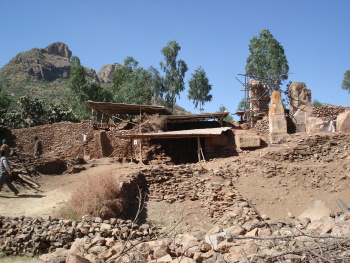The Cultural Heritage of Yeha

The Cultural Heritage of Yeha is part of the Tentative list of Ethiopia in order to qualify for inclusion in the World Heritage List.
The Cultural Heritage of Yeha comprises the ruins of the Great Temple and the Palace from the 1st millennium BC. The Temple is the oldest surviving structure in sub-Saharan Africa. It was built in the Sabaean style from South Arabia, which shows the exchange of ideas between both regions at the time. It belonged to a centralized state that was a predecessor to the Axumite Kingdom. The landscape also holds two groups of rockcut tombs from the same era.
Map of The Cultural Heritage of Yeha
Load mapThe coordinates shown for all tentative sites were produced as a community effort. They are not official and may change on inscription.
Community Reviews
Wojciech Fedoruk

Yeha is the remainings of the most ancient kingdom of present Ethiopia, which dates back to the 8th century BC. The Kingdom of Yeha maintained active contacts with Yemen and used the Sabaic language. In Yeha there is the oldest building still standing in Sub-Saharan Africa - the Great Temple once dedicated to Almaqah, the god of the moon (see photo). The temple was destroyed in the 6th century AD, when Christianity already reigned supreme in these areas, which, as we know, until recently did not like competition and actively suppressed it. The Christians did not turn the entire temple into a church, but partially demolished it to build their own place of worship nearby. In the Christian church there is a small museum with valuable artifacts, including over 1000-years-old liturgical books that the priest shows to visitors. It is also believed that the most ancient inscriptions of Sub-Saharan Africa were found in Yeha There are ancient tombs around the temple.
Next to it are the recently discovered ruins of the royal palace, where excavations are still ongoing.
Yeha is located about 50 km east of Aksum and is worth a short trip.
Haileyesus Haftu Gebreweld
It was by accident I happend to visit yeha while carring my routine feild duty in the central part of Tigray. The moment I saw it I felt ashamed for being part of this history but staying so long with out visiting it. offcourse my expectation was to see piles of stones of the first melinnium nothing more. Because that is how I was thought about it in a schol as well as by the local media.Later I found out how deep cultural and historical reppresion has had happend to Tigray,the most ancient part of Ethiopia. But by the time I saw the sharpness of angles of the block of stones, the heavyness as well as the smoothness of the surface of the stone blocks, I was taken by surprise as to how refined cutting smothing with inch priction was done at the remote past.I also felt hw Tigray was reprresed in the past three melina.Nevertheless, I for sure conclude that perhaps Yeha is the birth place of the science of geometry,heavey lifting crane and surfacing marble.Imagine rectangular stones .5*.5* 3.2 metres (about .8 cubic metre in volume and >1tonne in weight lifted as high as 10 metre around 3 thausand years ago and withstanding the ecological changes of the last three melina to stay erect.The water gutter at the flour is also another source of ammusment. For me I am short of words to describe it.The other ting which I conceived from then on,is the depth of deliberate subotage made to not publisize Tigrean historic sites. To make them out of the list of tourists destination. I pressume this was deliberately done so as to sustain poverty and self neglect in the tigray part of ethiopia.
Site Info
- Full Name
- The Cultural Heritage of Yeha
- Country
- Ethiopia
- Added
- 2020
- Type
- Cultural
- Categories
- Archaeological site - Civilizations of Sub-Saharan Africa
- Link
- By ID
Site History
2020 Revision
Successor to former TWHS Yeha (1978-1981)
2020 Added to Tentative List
1981 Deferred
At Bureau - Need Tentative List
1980 Deferred
1979 Deferred
Bureau meeting - info requested in 1978 still not in place
1978 Deferred
Bureau meeting - info requested
Site Links
Visitors
5 Community Members have visited.